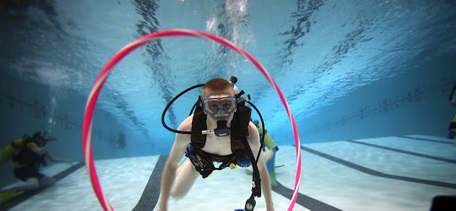Tim Callahan, Aquatic World Master Instructor, wrote the following article on the importance of Buoyancy control.
Have you ever been on a dive trip and wondered, “Why do we have to do an orientation dive? What are they looking for? I showed them my C-Card!” You might think – “they just want to see if I can clear my mask, share air, put my regulator on the tank (not-backwards)”. Now you would be right of course – those are the big smoking guns showing who might need a little extra help. However beyond that the Instructor-Divemaster is looking for comfort in the water, and the thing I personally look for is buoyancy control. You may have seen those divers – they don’t seem to move, and quite often also end up with air to spare. How do they do it? Well very often – Lots of Practice! A working Divemaster on a dive boat probably is in the water 12-14 hours a week for months at a time, plus teaching classes. They ought to look good! Don’t have that kind of time? Let me remind you of a few things to think about….
First – proper weighting. That skill you did in you open water class where you float at eye level – it actually had a purpose! If you can float at eye level with a full breath in your lungs and no air in your BCD you are properly weighted. (BUT – though rarely done - you really ought to do this with a nearly empty tank because all tanks become more buoyant as you use up the air. Up to 5.8 lbs for the typical Aluminum 80 so many of us use). Those good divers adjust their weight depending on the conditions – for salt vs. fresh water of course, but also for thickness and age of wetsuit, undergarments worn with a dry suit, type and size of tanks, and other changes in equipment. Experience of course gets you in the ballpark, but on most tropical trips I end up adjusting up or down a couple pounds to get it just right. Advantage? Proper weight means either not fighting to stay down if you were too light or less air in your BCD if you were too heavy and compensating with the BCD. Less air in your BCD means less change in volume as you ascend or descend which makes controlling buoyancy a lot easier. Another thing to consider, especially if you are new to diving - most people need less weight as they get more comfortable - so the weight you had in class may no longer be right for you even if all other factors are the same.
Second – proper trim. Once the weight is right you want to get it in the right place. If your fins are low, or your head is low, you are less streamlined and use more energy (and air). Maybe you need to move some weight from your pockets or belt somewhere else – making sure you can ditch the majority of the weight in an emergency of course. Also make sure it is equal from side to side so you stay on an even keel! I once had a good friend – who has been diving longer than I have - complain about turning to one side. It turned out they had 10 lbs. on one side and 6 on the other. We called off our dive and spent 45 minutes arranging weights and trying different configurations – including swapping tanks. Special Cases – ever hear of Stingray City in Grand Cayman where you dive with and feed stingrays? You purposely wear extra weight there because it is quite shallow. There are also cases where you might want your feet low or head low.
Third – relax and slow down. We all feel like we are flailing a bit at times of course – including those picture perfect folks – they just do it less so you don’t catch them! Take some time and pay attention to how you are feeling buoyancy-wise. If you stop swimming what happens? Ideally you stay pretty much where you were, and pretty much in the same position. We don’t often hit ideal of course, but if your position at least changes slowly you are getting close.
Did you know there is actually a PADI Specialty class called Peak Performance Buoyancy? It includes two dives devoted to buoyancy control. I suspect most people think – “well that’s a Nothing Burger class!”, and for some it may well be, but for others it might just get you “where you want to be” as a diver and is worth considering. Next time you are in the water devote some time to really fine tuning your buoyancy.
Join instructors Tim Callahan and Pete Durdon this Saturday February 23rd for a Buoyancy Workshop at Aquatic World. It will be held at 2PM. Spaces limited. Call the shop for details.


